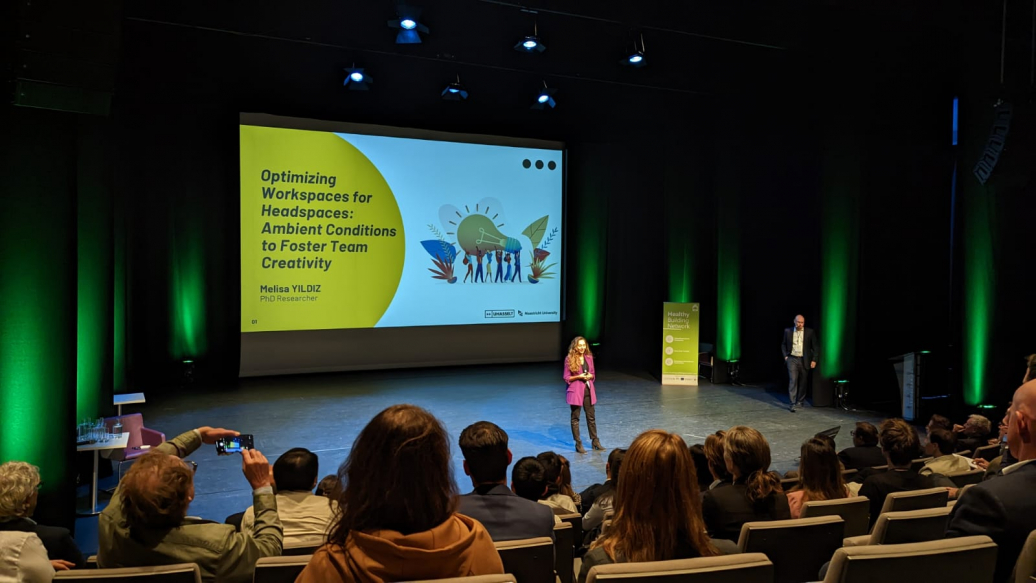Interview with Melisa Yildiz, Ph.D. Candidate at Hasselt University, BE and Maastricht University, NL, and Felix van den Horst, CEO of Clairify B.V.
Can the right ambient conditions foster team creativity? That is precisely what Melisa Yildiz is researching at the moment. She presented the results she's gotten at the HealthBuild conference, and they look very promising. We wanted to know more about Melisa's research and potential outcomes:
- Melisa, what is your research about, and what are the key findings so far?
M: My research is about understanding innovative human behavior in the context of their physical environment: how their cognition and innovativeness are affected by indoor air quality. I am very excited about the key findings! We saw that people showed less collaboration and creativity in spaces where the air quality was worse. In contrast, their overall collaborative spirit and innovativeness were higher when the air quality was ideal. If we shed light on these dependencies, we can help organizations enhance creativity and innovation through better space management. This is a novel aspect in academia that no research has ever touched on the way we do, so I am thrilled to show the first findings to the world!
- Could you describe the experiment you conducted?
M: We used the setting of an undergraduate course in Maastricht University SBE. We observed how the interactive creative performance between the students changed with the change in the air quality of the room. We watched people's behavior and surveyed their perceived creative performance and interaction. We used the Clairify sensors to track temperature, noise, and pollution in the room throughout the experiment.

- As you've mentioned the Clarify sensors - why did you choose them? And what is the company's role in your research?
M: We wanted to measure our research variables in the clearest, most fine-tuned, and easy-to-use way possible. Clairify sensors met all our requirements: a variety of precise measurements, flexibility - no need to install the sensors permanently, and the ability to track everything in real-time via the dashboard. We partnered with Clarify, and I think our collaboration has been very fruitful.
- Felix, why is Clairify interested in this research? And how do you perceive the collaboration with the University?
F: We believe that human-centric environmental data is key to creating healthy, enjoyable, and productive workspaces for people and organizations worldwide. Melisa's research sheds light on the topic from a new angle by focusing on creativity and team cooperation and understanding how the indoor environment directly influences these factors. This can lead to new findings, pushing the scientific community forward and helping companies understand the real-life implications of the office and its indoor environment on their people. For Clairify, it is a very enriching experience to collaborate with a thought leader in the space of healthy buildings and real estate, such as Maastricht University. We are thrilled to be a contributing part of such innovative research.

- This sounds like a truly forward-looking approach! Melisa, how do you see the future of your research?
M: The next step is to move this research into a bigger organizational setting. After the pilot study with an educational setting in the University, we know that the indoor environment of the workspaces is an influential factor in the success of the innovative activities of teams. I am eager to move this into a bigger organizational setting with working teams interested in testing their indoor environment's effect on their innovative performance.
- It is getting even more exciting! Felix, what about you? Is this something in Clairify's roadmap?
F: I think it's key to demonstrate with numbers how people evolve in their roles and day-to-day activities under different environmental conditions. Understanding what happens in an educational setting is one thing, but bringing the knowledge to the workspace is another level. And we're very pleased to see great interest in this coming from the market. We're currently discussing with a major consultancy firm to develop this pilot in one of their office buildings in the Netherlands, so it is definitely part of Clairify's roadmap.
- So good to hear! Fingers crossed, everything proceeds smoothly! To summarize our conversation, Melisa, what are your expectations of the potential outcomes? What impact will they have? What is the benefit for the end-user?
M: I expect the impact to be on multiple aspects. We are looking into optimizing the indoor in a way that would make the occupants the most comfortable. They'd be comfortable thinking about their tasks and developing innovative solutions. On top of that, they'd be comfortable sharing their ideas with colleagues, enhancing collaboration. The benefit for the end-user, the companies, is that by knowing how to optimize their workspaces, they will have physically and mentally healthy employees using the full potential of their skillset in a collaborative and innovative environment.
Curious about how you could optimize your workspaces?

By: Valerie Spangenberg (Clairify B.V.) and Tetiana Kotiuk (Maastricht University).
Maastricht University Article.